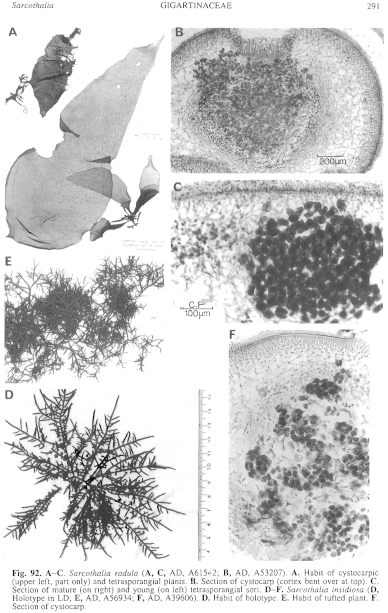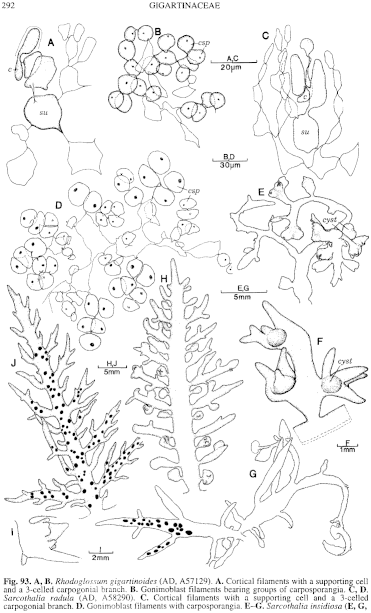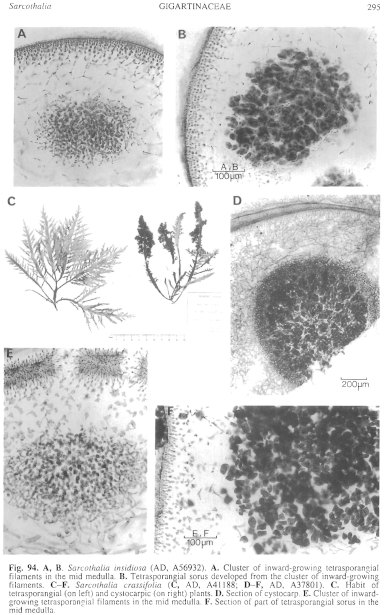|
|
|
|
|
|||||||||||
|
Electronic Flora of South Australia Species Fact Sheet
Phylum Rhodophyta – Class Florideophyceae – Order Gigartinales – Family Gigartinaceae
Synonym
Gigartina insidiosa J. Agardh 1899: 22. De Toni 1924: 181. Setchell & Gardner 1933: 294; 1934: 136.
Thallus (Fig. 92D, E) dark brown-red, forming more or less pulvinate or clumped masses 2–6 (–10) cm high and 2–10 cm across, much branched with entangled, pinnate, main branches (Fig. 92D) and laterals, some branches often arched and with branch apices forming attachment haptera (Fig. 93G) to the substrate. Main branches compressed, 2–4 (–5) mm broad, lesser branches terete to slightly compressed, 1–3 mm broad, basally attenuate, broader above and tapering apically, often curved. Holdfasts numerous in clumped plants, small and discoid; epilithic. Structure of a compact cortex of anticlinal, subdichotomous filaments, outer cells 1–2 µm in diameter and L/D 1–2 (–3), and a medulla of slender anastomosing filaments.
Reproduction: Carpogonial branches 3-celled, on inner cortical (supporting) cells within small branchlets which later bear 1–6 swollen cystocarps. Cystocarps (Fig. 93E, F) borne on short laterals on lower parts of main branches, 1–1.3 mm across, becoming involucrate with 3–5 pinnules, with moderate enveloping tissue of elongate cells (with some transverse absorbing filaments) and a carposporophyte (Fig. 92F) with a filamentous matrix and numerous groups of ovoid carposporangia, developed in clusters of 2–4, each 12–20 µm in diameter. Spermatangia not observed.
Tetrasporangial sori (Fig. 93G) maculate, scattered over lesser branchlets, 0.5–1 mm across, developed from a cluster of branched, inward-growing, secondary filaments (Fig. 94A) originating in the mid medulla, with the earlier-formed cells of the filaments (plus some cut off laterally) transformed into tetrasporangia forming a globular mass (Fig. 94B) in the mid to inner medulla. Tetrasporangia ovoid, 20–28 µm in diameter, irregularly cruciately divided.
Type from Port Elliot, S. Aust. (Hussey); holotype in Herb. Agardh, LD, 23742.
Selected specimens: Pearson I., S. Aust., upper sublittoral (Specht, 17.ii.1960; AD, A24504, A24541). Middle R., Kangaroo I., S. Aust., lower eulittoral (Womersley, 19.i.1947; AD, A4273). Robe, S. Aust., upper sublittoral pools on slipway reef (Womersley, 24.viii.1960; AD, A24426). Cape Lannes, S. Aust., near low tide level (Edyvane, 21.vii.1984; AD, A56932). Nora Creina, S. Aust., 3–8 m deep (Owen, 3.ix.1971; AD, A39606). Port MacDonnell, S. Aust., drift (Womersley, 20.viii.1984; AD, A56934). Port Arthur, Tas., lower eulittoral (Cribb 117.10, 26.i.1951; AD, A16198).
Distribution: Pearson I., S. Aust., to Port MacDonnell, S. Aust., and from Port Arthur, Tasmania, forming mats or clumps under moderate wave action just above and below low tide level.
Taxonomic notes: Sarcothalia insidiosa is distinguished by development of the tetrasporangia from cells of clusters of inward-growing filaments (many of which have their end cells pit-connected with medullary cells), resulting in sori deep within the medulla. In tetrasporangial development it is related to S. crassifolia and S. radula but clearly distinct in habit and dimensions. The characteristic low, entangled, habit is a result not only of the curved pinnules and pinnae, but also of the apices of the pinnules forming attachments or secondary holdfasts to the substratum. In this latter respect it resembles S. crassifolia, but is clearly different in being much more slender with juvenile plants low and entangled. The cystocarps are borne on short laterals on lower parts of the main branches, and develop 3–5 prominent involucral pinnules. The type specimen has well-developed percurrent branches, whereas most specimens form clumps with erect branches less well developed than in the type.
The New Zealand Gigartina laingii Lindauer (1939; Alg. Nova-Zel. Exsicc. 49) is similar morphologically to S. insidiosa and occupies a similar ecological niche. It may prove to be specifically identical.
References:
AGARDH, J.G. (1899). Analecta Algologica. Cont. V. Acta Univ. lund. 35, 1–160, Plates 1–3.
DE TONI, G.B. (1924). Sylloge Algarum omnium hucusque Cognitarum. Vol. 6. Florideae. (Padua.)
LINDAUER, V.W. (1939). Algae Nova-Zelandicae Exsiccatae. Fasc. 2, numbers 26–50. (Issued June 1939).
SETCHELL, W.A. & GARDNER, N.L. (1933). A preliminary survey of Gigartina, with special reference to its Pacific North American species. Univ. Calif Pubis Bot. 17, 255–340.
SETCHELL, W.A. & GARDNER, N.L. (1934). De Gigartinis. Rev. Algol. 7, 131–138.
The Marine Benthic Flora of Southern Australia Part IIIA complete list of references.
Publication:
Womersley, H.B.S. (14 January, 1994)
The Marine Benthic Flora of Southern Australia
Rhodophyta. Part IIIA, Bangiophyceae and Florideophyceae (to Gigartinales)
Reproduced with permission from The Marine Benthic Flora of Southern Australia Part IIIA 1994, by H.B.S. Womersley. Australian Biological Resources Study, Canberra. Copyright Commonwealth of Australia.
Illustrations in Womersley Part IIIA, 1994: FIGS 92 D–F, 93 E–G, 94A, B.

Figure 92 enlarge
Fig. 92. A–C. Sarcothalia radula (A, C, AD, A61542; B, AD, A53207). A. Habit of cystocarpic (upper left, part only) and tetrasporangial plants. B. Section of cystocarp (cortex bent over at top). C. Section of mature (on right) and young (on left) tetrasporangial sori. D—F. Sarcothalia insidiosa (D, Holotype in LD; E, AD, A56934; F, AD, A39606). D. Habit of holotype. E. Habit of tufted plant. F. Section of cystocarp.

Figure 93 enlarge
Fig. 93. A, .B. Rhodoglossum gigartinoides (AD, A57129). A. Cortical filaments with a supporting cell and a 3-celled carpogonial branch. B. Gonimoblast filaments bearing groups of carposporangia. C, D. Sarcothalia radula (AD, A58290). C. Cortical filaments with a supporting cell and a 3-celled carpogonial branch. D. Gonimoblast filaments with carposporangia. E–G. Sarcothalia insidiosa (E, G, AD, A56932; F, AD, A16198). E. Branchlets with cystocarps. F. Cystocarps with involucral pinnules. G. Branchlets with attachment haptera and tetrasporangial sori. H–J. Sarcothalia crassifolia (AD, A55439). H. Branch with cystocarps, I. Cystocarp with involucral ramuli. J. Branch with maculate tetrasporangial sori.

Figure 94 enlarge
Fig. 94. A, B. Sarcothalia insidiosa (AD, A56932). A. Cluster of inward-growing tetrasporangial filaments in the mid medulla. B. Tetrasporangial sorus developed from the cluster of inward-growing filaments. C–F. Sarcothalia crassifolia (C, AD, A41188; D–F, AD, A37801). C. Habit of tetrasporangial (on left) and cystocarpic (on right) plants. D. Section of cystocarp. E. Cluster of inward-growing tetrasporangial filaments in the mid medulla. F. Section of part of tetrasporangial sorus in the mid medulla.

|
Email Contact: State Herbarium of South Australia |

|